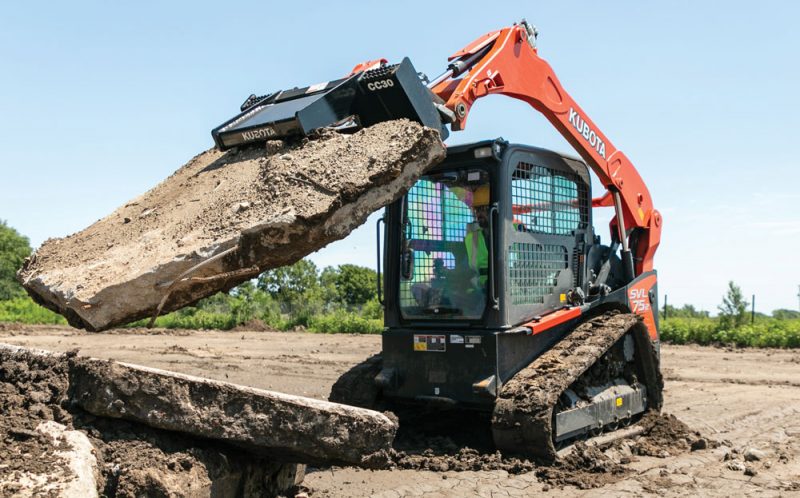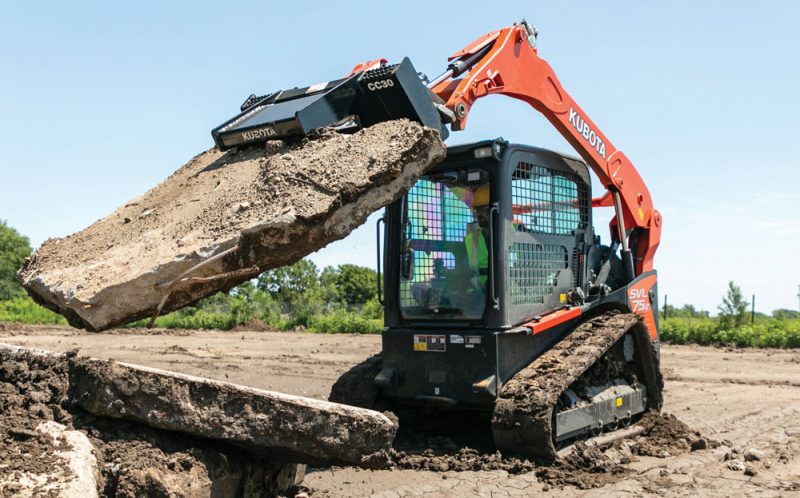Skid steers are known for their versatility on construction sites, but have you ever wondered if they can handle demolition work? Well, you’ve come to the right place! In this article, we’ll explore whether skid steers, those compact and agile machines, are up to the task of demolishing structures. So, if you’re curious about the capabilities of these powerful machines and their potential role in demolition projects, keep reading!
When it comes to construction work, skid steers are like the Swiss Army knives of heavy machinery. They can perform a wide range of tasks such as digging, grading, and lifting heavy materials. But what about more specialized jobs, like demolition? Can skid steers handle the rigors of tearing down structures? We’re about to find out!
Demolition work requires precision, power, and efficiency. It involves breaking down buildings, removing debris, and clearing the site for future development. Skid steers are designed to be nimble and maneuverable, which makes them ideal for navigating tight spaces and confined areas. But are they strong enough to handle the intensity of demolition? Let’s dig deeper to uncover the answer!

Can Skid Steers Handle Demolition Work? Exploring Their Versatility and Efficiency
Skid steers are versatile machines that are commonly used in construction and landscaping. But can they handle the demanding task of demolition work? In this article, we will delve into the capabilities of skid steers and discover how they can excel in various demolition applications. From tearing down structures to hauling away debris, skid steers have become a reliable choice for many contractors. Let’s explore their features, attachments, and benefits that make them well-suited for the challenges of demolition work.
The Versatility of Skid Steers in Demolition Work
Skid steers are compact machines equipped with a rigid frame, a powerful engine, and a set of wheels or tracks. These features allow them to navigate tight spaces and maneuver easily, making them ideal for demolition projects where precision is crucial. Whether it’s an interior demolition in a residential area or clearing out a construction site, skid steers provide the agility and mobility necessary to get the job done efficiently.
One of the primary advantages of skid steers is their ability to accommodate a wide range of attachments. These attachments can transform the machine into a versatile tool that can handle various demolition tasks. From hydraulic breakers and grapples to concrete crushers and buckets, skid steers can be customized to suit the specific requirements of any demolition project. Additionally, the quick-attach system allows operators to attach and detach these tools rapidly, saving time and increasing productivity on the job site.
The Benefits of Skid Steers in Demolition Work
Skid steers offer several benefits that make them an excellent choice for demolition work:
- Maneuverability: Skid steers can access confined spaces, navigate uneven terrain, and easily turn on the spot, allowing operators to work in tight areas with ease.
- Power and Performance: Despite their compact size, skid steers are equipped with powerful engines that deliver impressive performance, enabling them to tackle demanding demolition tasks.
- Attachment Versatility: With a vast selection of attachments available, skid steers can be tailored to handle various demolition applications, eliminating the need for multiple specialized machines.
- Time and Labor Efficiency: The ability to quickly interchange attachments and the efficient operation of skid steers contribute to increased productivity and reduced labor requirements on the job site.
- Cost Savings: By using skid steers for demolition work, contractors can save money by eliminating the need for additional machinery and reducing manual labor costs.
Maximizing Efficiency: Tips for Using Skid Steers in Demolition Work
To ensure optimal performance and safety when using skid steers for demolition work, consider the following tips:
- Choose the Right Attachments: Assess the specific requirements of the demolition project and select the appropriate attachments for the skid steer. This will enhance efficiency and ensure that the machine is equipped to handle the tasks at hand.
- Implement Proper Operator Training: Skid steers require skilled operators who are familiar with the machine’s controls, attachments, and safety protocols. Investing in proper training will maximize efficiency and minimize the risk of accidents.
- Maintain Regular Inspections and Maintenance: Conduct routine inspections to identify any potential issues before they escalate. Adhering to a maintenance schedule will extend the lifespan of the skid steer and prevent unexpected breakdowns during demolition work.
- Follow Safety Procedures: Demolition work involves inherent risks. Always follow safety protocols, provide appropriate personal protective equipment (PPE) to operators, and ensure a safe working environment for everyone on the job site.
The Future of Skid Steers in Demolition Work
As technology continues to advance, we can expect even more innovative features and attachments for skid steers, further enhancing their performance in demolition work. With the ability to remotely control skid steers, operators can safely navigate hazardous environments. Additionally, advancements in hydraulic systems and attachments will make skid steers even more efficient and versatile, revolutionizing the demolition industry.
Conclusion
Skid steers have proven their worth in the world of demolition work. Their compact size, maneuverability, and attachment versatility make them well-suited for a wide range of demolition tasks. By utilizing the right attachments and following safety procedures, contractors can maximize the efficiency and productivity of skid steers in their demolition projects. As technology continues to evolve, we can expect skid steers to play an increasingly significant role in the demolition industry. So, the answer to the question, “Can skid steers handle demolition work?” is a resounding yes!
Key Takeaways: Can skid steers handle demolition work?
- Skid steers are versatile machines that can be used for various construction tasks, including demolition work.
- With their compact size and maneuverability, skid steers can access tight spaces that larger machines may struggle with.
- Skid steers equipped with attachments like hydraulic breakers or grapples can easily handle demolition tasks such as breaking down concrete structures or clearing debris.
- Operators with proper training and experience can effectively and safely operate skid steers for demolition work.
- However, it is important to assess the specific requirements of each demolition project and determine if a skid steer is the most suitable machine for the job.
Frequently Asked Questions
If you’re considering using a skid steer for demolition work, you might have some questions. Here are answers to some commonly asked questions about using skid steers for demolition.
1. Can skid steers be used for demolition work?
Absolutely! Skid steers are versatile machines that can handle a variety of tasks, including demolition work. With the right attachments and proper operator training, skid steers can efficiently tear down structures, remove debris, and clear the site.
Skid steers are particularly useful for interior demolition, where they can easily maneuver in tight spaces and navigate through doorways. Their compact size allows them to access areas that larger machinery cannot reach, making them an ideal choice for small-scale demolition projects.
2. What attachments are needed for skid steers to handle demolition work?
Skid steers can be equipped with various attachments to enhance their demolition capabilities. Common attachments for skid steers used in demolition work include hydraulic breakers, grapples, shears, and buckets.
A hydraulic breaker attachment, for example, is ideal for breaking down concrete and other tough materials. Grapples and shears can be used to grab and cut through debris, while buckets are useful for removing and transporting the demolished materials. The choice of attachment depends on the type of demolition work being performed.
3. Are skid steers powerful enough for demolition tasks?
Yes, skid steers can pack quite a punch when it comes to demolition tasks. While they may not have the same raw power as larger excavators or bulldozers, skid steers are still capable of handling a significant amount of demolition work.
The key is to choose the right size and horsepower of skid steer for the specific demolition job. Small- to medium-sized skid steers are suitable for most interior demolition projects, while larger skid steers with higher horsepower can handle heavier demolition tasks. It’s essential to assess the requirements of the job and select the appropriate skid steer accordingly.
4. What are the advantages of using skid steers for demolition work?
Using skid steers for demolition work offers several advantages. Firstly, their compact size allows them to access confined spaces, making them highly maneuverable on job sites. They can easily navigate around obstacles and work within tight areas where larger machinery cannot reach.
Skid steers are also versatile machines. With various attachments available, they can be adapted for different demolition tasks, making them a cost-effective and efficient choice. Additionally, skid steers are relatively easy to operate and require minimal training, which can save time and money.
5. What safety measures should be taken when using skid steers for demolition work?
When using skid steers for demolition work, it’s crucial to prioritize safety. Operators should receive proper training on the specific attachments and equipment being used, as well as general safety procedures for demolition work.
Wearing appropriate personal protective equipment (PPE), such as hard hats and safety goggles, is essential. Regular maintenance and inspections of the skid steer and attachments should also be conducted to ensure everything is in proper working order. Finally, a thorough assessment of the work site should be done to identify potential hazards and implement necessary safety measures.
Summary
Skid steers are versatile machines that can handle various tasks on a construction site. However, when it comes to demolition work, there are some limitations to consider.
First, skid steers have smaller frames and less power compared to other heavy machinery like excavators. This means they may not be able to handle large-scale demolition projects or break through solid structures.
Second, skid steers are best suited for smaller demolition jobs such as removing interior walls or tearing down small structures. They can navigate tight spaces and make precise movements, making them useful in certain situations.
In conclusion, while skid steers can handle some demolition work, they may not be the most efficient choice for larger or more complex projects. It’s important to assess the specific requirements of each demolition job and consider alternative machinery when necessary.

